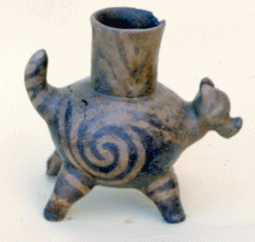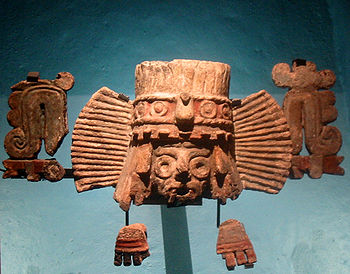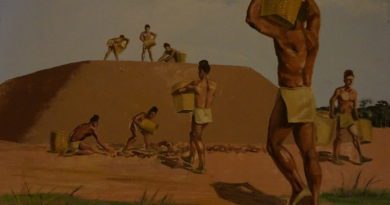Ancient Chihuahuas in Southeastern U.S.?
Other Evidence from Dog Effigy Sites in Georgia That Support a Mexican Origin
The pot includes a swirling design painted on its surface that suggests it was associated with the Creek Indian Wind Clan. Creek tradition holds that the Wind Clan was the most ancient clan among the tribe and the “aristocracy of all the clans.”27 This symbol was also associated with Ehecatl-Quetzalcoatl, the god of wind, in Mexico. This spiral symbol can be seen on many pots from Casas Grandes.
 |
 |
|
Spiral design on Bull Creek dog effigy pot |
Casas Grandes pot with similar spiral design. |
A pipe unearthed from the Bull Creek site also has features found on artifacts in Mexico. It features the portrait of an apparently important person wearing a distinctive headdress. The headdress includes a band around its bottom featuring circled dots or circumpunct designs identical to those seen on the headdress of the Mexican deity Tlaloc.
 |
|
| Pipe from Bull Creek site with distinctive headdress featuring circled-dots or circumpuncts and possible rattlesnake rattles centered on front and back | Tlaloc statue from Mexico with same distinctive headdress featuring circumpuncts (Courtesy Wikipedia.) |
Artifacts from the Nacoochee site also are suggestive of an origin in west Mexico. For example, parts of earthenware pipe rims show ornamentation in the form of birds that appear to include representations of the scarlet macaw. Similar representations can be found on pots from Casas Grandes.
 |
|
| Earthenware pipe rim ornaments from Nacoochee sitefeaturing macaws or Carolina parakeet | Casas Grandes pot with scarlet macaw head adornos. |
In the book Archaeological Survey in the Lower Mississippi Alluvial Valley, 1940-1947, the authors make note in the section “Distribution of some Mississippi Vessel Shapes and Features” how many of the vessel types and designs found in the southeast have their closest equivalents at Casas Grandes28 providing more evidence to support this argument.
Conclusions
The dog pots excavated from the Bull Creek and Neisler sites in southwest Georgia likely represent the Chihuahua breed, a native dog of Mexico, probably derived from the Techichi breed. The dog pots in Georgia are similar to those from Colima in west Mexico and both were used as grave goods in their respective locations. The Kasihta tribe are the likely producers of these Georgia dog pots and their migration legends strongly suggest an origin in west Mexico, likely Colima, which is supported by evidence from old maps of Georgia which indicated that a tribe named Colooma lived near the Bull Creek site in 1755.
There is also an unexpected outcome of this research: the resolution of the origins of the Chihuahua. There has been considerable conjecture about how the Chihuahua breed was derived from the Techichi. Many theories argue that the Chihuahua is a modern breed created after the arrival of Europeans which resulted from a cross between a Techichi with dogs from China or Europe to achieve the modern toy-size Chihuahua. Yet the appearance of these Chihuahua effigies in Mexico by 100 AD and the dog effigy pots in Georgia by 1325 AD seems to refute those claims and suggests the Chihuahua has purely New World origins.
[Adapted from the paper “Possible Representations of Mexican Chihuahua Breed on Dog Effigy Pots from Georgia?“]




Pingback: Looking Back in Time; Pre-Columbian Dog Breeds! | Daycare & Grooming Blog